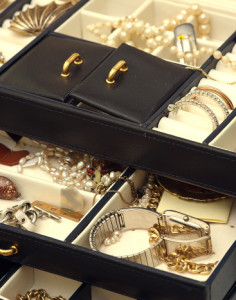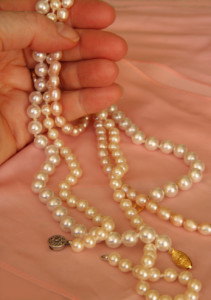Jewelry Care

Wentworth Jewelers wants you to continue to enjoy your items from our fine jewelry
collection for generations. If you familiarize yourself with the following
checklist, this should easily be accomplished.
- Always remove fine jewelry when working with cleaning
and other corrosive chemicals. Fine jewelry should never be exposed to bleach,
ammonia and other common kitchen and bathroom cleaners. The use of gloves is not
recommended because prongs and edges can easily catch and create damage when pulling
gloves off.
- Swim with water-wings or life jackets, not jewelry.
Jewelry should not be worn in pools, as chlorine can break down prongs and settings
over time as well as cause interactions with your skin. Additionally,
do not wear your jewelry into the ocean where salt water, waves and sand can easily
damage jewelry. It is also a good idea to remove your jewelry before bathing
or showering as the temperature or force of the water can lead to loosing jewelry
- When getting dressed, put your jewelry on
last. This prevents jewelry from getting snagged in clothes and hair.
Also when you wear perfume or fragrance, or use hairspray always allow up to five
minutes before placing on your jewelry, as these products contain alcohol, which
is particularly damaging.
- Pearls—Pearls are porous and thus will absorb chemicals,
salts, fragrances, etc. This causes pearls to loose their luster and can cause
them to break down.. Pearls should be separated from all other jewelry, and if kept
in lined drawers of jewelry boxes or placed in silk pouches (easily available),
should last a life-time.
- Separate your jewelry either in a jewelry box (preferably
lined with a non-abrasive cloth) and that contains dividers. When jewelry
is placed together, chains become tangled, and the abrasion of metal rubbing on
metal can damage prongs and contribute to loosing stones. Chains are best
hung on individual hooks in a jewelry box or in closets, etc.
Cleaning Jewelry
Wearing and properly placing your jewelry will actually help keep your jewelry clean
and prevent tarnish. However, when some cleaning is necessary, use silver
clothes to wipe gold and silver. Over the counter jewelry cleaners are generally
safe for all stones, with the exception of pearls and some opals. However
it is generally never a good idea to leave your fine jewelry soaking for extended
periods of time. Simply place in the container that comes with the cleaner,
remove no more than 15 minutes later, and use a soft toothbrush to assist with removing
build-up around stones.
Do not wear your jewelry if your ears are infected or if you have certain types
of rashes or allergic reactions. All of these can be spread through
jewelry.
Inspect your fine jewelry regularly

At least once a year, inspect your jewelry. Here are things to look for:
- Chains and bracelets: Look for areas where kinks,
or weight or stress can weaken the chain. Are the clasps functioning properly
and are the safely catches working.
- Rings: Inspect the shank to determine if
any area of the band has become thin and could break. Also check the prongs
around gemstones to make sure that none have broken or worn down. Another
way to tell if you might loose a stone is to gently try to rotate a stone. If the
stone moves, the setting is loose.
- Earrings: Check the posts, loops, levers
and backs to make sure the pieces are secure and retain appropriate tension.
Verdigris
Verdigris is the green gunk that we have probably all seen on jewelry at some time.
It is the result of moisture, makeup, and chemicals over time but it is a living
bacteria that will grow and continue to cause damage. Infected jewelry can
spread the bacteria to other jewelry. Common places for verdigris are backs, clasps,
spacers on chains and posts. For this reason, it is always best to thoroughly
clean vintage jewelry selected out of boxes or cases at flea markets or estate sales.
If you find verdigris, if it is on inexpensive costume or fashion jewelry, you might
consider throwing the piece away. Otherwise, it can be treated with
lemon juice, vinegar and even catsup, but the process may remove finishes if the
piece is not fine jewelry.